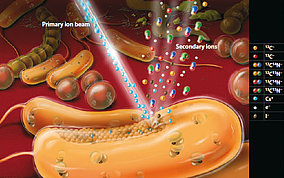About SIMS

- Schematic illustration of a dynamic secondary ion mass spectrometry (SIMS) analysis of a bacterialbcommunity (not to scale). The bacterial cell sputtered with the primary ion beam is labeled with 15N and 13C. Only selected secondary ions are displayed. Note that nitrogen is detected as cyanide ion and that isobaric ions are formed (e.g., 12C15N− and 13C14N−), whose differentiation requires high mass resolution as offered, for example, by modern NanoSIMS instruments. In addition, the analyzed rod-shaped cell is also labeled with an iodized oligonucleotide probe targeting the ribosomal RNA. If sufficient cellular material is removed by sputtering to allow secondary ion formation from the ribosomes (displayed in the cell lumen), iodine ions (I−) can also be detected in the secondary ions. Figure by Gerhard Pucher.
SIMS (or ion microprobing) is an extremely sensitive mass spectrometric technique that determines the elemental, isotopic, or molecular composition of a solid sample surface. SIMS uses an energetic primary ion beam generated by an ion gun to produce and expel under high vacuum secondary particles (primarily atoms or molecules depending on the SIMS mode) from the sample surface (Figure 2). These particles can be neutral or positively or negatively charged. Charged particles of one polarity are extracted from the sputtering area by an electric field. These secondary ions are then focused by an extraction lens and the secondary ion beam is analyzed by mass spectrometry. Although virtually all elements can be analyzed by SIMS, different elements possess different secondary ion yields and consequently their SIMS detection limit varies dramatically. SIMS is applied in two different modes to bombard the surface of the sample. Dynamic SIMS uses a continuous ion beam at a high dose so that the number of incident ions is higher than the number of surface atoms of the sample. Dynamic SIMS instruments are commonly equipped with a duoplasmatron source producing a negatively (or positively) charged primary oxygen ion beam and a cesium source for generating a Cs+ primary ion beam for the enhanced generation of positively and negatively charged secondary ions, respectively. Owing to the high dose of primary ions,almost all molecules at the sample surface are completely fragmented and the sample surface erodes rapidly (up to several tens of microns per hour, dependent on the instrument and analytical conditions), permitting depth analysis of the sample composition. Thus, dynamic SIMS provides information on the elemental and isotopic composition of a sample with high sensitivity by using sector field or quadrupole mass analyzers for the measurement of the secondary ions. In modern instruments such as the NanoSIMS 50LTM (CAMECA) up to seven elements or isotopes of elements can be measured simultaneously, and this feature also enables researchers to determine precise isotope ratios of the sample.
for Advanced Isotope Research
University of Vienna
Althanstraße 14
A-1090 Vienna
T: +43-1-4277-573 14
F: +43-1-4277-543 89




